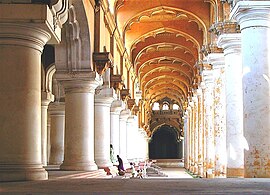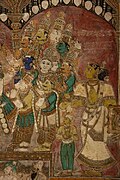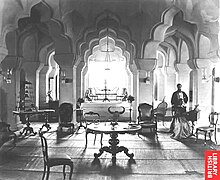Mangammal
| Rani Mangammal | |
|---|---|
| Queen Regent of Madurai Nayak Kingdom | |
 Rani Mangammal with her grandson Vijaya Ranga Chokkanatha c.17th–18th century | |
| Nayak (Rani) of Madurai | |
| Reign | 1689–1704 |
| Predecessor | Rangakrishna Muthu Virappa Nayak |
| Successor | Vijaya Ranga Chokkanatha Nayak |
| Born | Madurai |
| Died | 1705 Madurai, present dayTamil Nadu, India |
| Spouse | |
| Issue | Rangakrishna Muthu Virappa Nayak |
| House | Madurai Nayaks |
| Father | Tupakula Lingama Nayaka |
| Kings and Queen Regents of Madurai Nayak Dynasty | |
|---|---|
| Part of History of Tamil Nadu | |
 | |
| Madurai Nayak rulers | |
| Viswanatha Nayak | 1529–1563 |
| Kumara Krishnappa Nayak | 1563–1573 |
| Joint Rulers Group I | 1573–1595 |
| Joint Rulers Group II | 1595–1602 |
| Muttu Krishnappa Nayak | 1602–1609 |
| Muttu Virappa Nayak | 1609–1623 |
| Tirumala Nayak | 1623–1659 |
| Muthu Alakadri Nayak | 1659–1662 |
| Chokkanatha Nayak | 1662–1682 |
| Rangakrishna Muthu Virappa Nayak | 1682–1689 |
| Rani Mangammal‡ | 1689–1704 |
| Vijaya Ranga Chokkanatha Nayak | 1704–1731 |
| Queen Meenakshi‡ | 1731–1736 |
| ‡ Regent Queens | |
| Capitals | |
| Madurai | 1529–1616 |
| Tiruchirapalli | 1616–1634 |
| Madurai | 1634–1665 |
| Tiruchirapalli | 1665–1736 |
| Major forts | |
| Madurai 72 Bastion Fort | |
| Tiruchirapalli Rock Fort | |
| Dindigul Fort | |
| Thirunelvelli Fort | |
| other Military forts | |
| Namakkal Fort | |
| Sankagiri Fort | |
| Attur Fort | |
| Palaces | |
| Thirumalai Nayak Mahal, Madurai | |
| Chokkanatha Nayak Palace a.k.a. Durbar Hall, Tiruchirapalli | |
| Rani Mangammal Tamukkam palace Madurai | |
Rani Mangammal was the queen during the reign of King Chokkanatha Nayak. After his death in 1682 AD, she broke tradition by refusing to commit Sati, and proclaimed her only son, the 15 year old Muttu Virappa Nayak III, as the next king. As regent, she guided him in governing the kingdom. When King Muttu Virappa Nayak III died in a battle at the age of 22, Mangammal protected his pregnant wife from committing Sati. Mangammal became the first queen in the Madurai Nayak dynasty.
During her reign, the Nayak kingdom began paying revenue to the Mughal emperor Aurangazeb, to secure protection from Mysore and Tanjore kingdoms. Like some of her predecessors, Mangammal shifted her capital to Tiruchirappalli. The Ramnad part of her kingdom declared independence under Sethupathy. Her reign is remembered for its vigor, diplomacy and prudent administration, which extended the lifespan of the Nayak kingdom. Mangammal demonstrated remarkable religious tolerance, supporting Christian missionaries, granting funds for mosque and Hindu temples maintenance. She focussed on irrigation and constructed inns with water facilities for travelers. Despite multiple versions of her death, her 18-year reign is celebrated for her governance and dedication to the welfare activities in the late dynasty.
Life
Mangammal was the daughter of Tupakula Lingama Nayaka, a General of the Madurai ruler, and the wife of Madurai ruler Chokkanatha Nayak (1659–1682) himself. She married Chokkanatha Nayak and became the mother of Rangakrishna Muthu Virappa Nayak (1682—1689).[1]
When her husband died in 1682, he was succeeded by her son, Rangakrishna Muthu Virappa Nayak. Upon the death of her son in 1689, her son's widow was pregnant. Her son was succeeded by her grandson in 1689. Her daughter-in-law committed sati, and Mangammal became regent during the minority of her grandson, Vijaya Ranga Chokkanatha.[1][2]
Regency
During Mangammal's regency, many irrigation channels were repaired, new roads were constructed, avenue trees were planted, and several municipal buildings were completed, including temples and her "Spring Palace" at TumKum (Thamukkam).[3] The "Spring Palace" now houses the Gandhi Memorial Museum in Madurai.[3] The highway from Cape Comorin was originally built during the time of Mangammal and it was known as Rani Mangammal Salai.[2][4]
She played a key role in assisting the Mughal Army during the Siege of Jinji (Gingee). Queen Mangammal had realized that the renegade Rajaram had entrenched himself within Jinji and had been bent upon attacking Thanjavur and Madurai if the Mughal Army were to withdraw. Mangammal soon recognized Aurangzeb as her suzerain and began to assist Zulfiqar Khan in attacking the Jinji fort. When the fort was captured by both Zulfiqar Khan and Mangammal after 8 years, she and her family had control over the fort under the leadership of the Mughals.
When her grandson, Vijayaranga Chokkanatha Nayaka, came of age in 1704, she and her prime minister, Achayya, refused to relinquish power. They were seized by the army commander and executed.[2][5]
Rani Mangammal first celebrated the Unjal festival in Meenakshi temple during the Tamil month of 'Ahni'. During the festivities, all the royal families visit the temple and pay tribute to Meenakshi Amman. Even today, we can see her contemporary portrait in the Unjal Mandapam.
Gallery
- Marriage function is witnessed by the Devas and Rani Mangammal and Muthu Vijayaranga Chokkanatha Nayak.
- Queen's Summer Palace
- Queen's Summer Palace
- sculpture of Mangammal
References
- ^ a b Madhavananda, Swami; Majumdar, Ramesh Chandra, eds. (1953). Great Women of India. Mayavati, Almora, Himalayas, Uttarakhand: Advaita Ashrama. pp. 341–342. OCLC 602056.
- ^ a b c E.H.B. (1899). "Mangamma's Folly". Calcutta Review. 109 (218 (October 1899)): 350–352.
- ^ a b Pal̲aniyappan̲, Ki (1963). The Great Temple of Madurai: English version of the book Koilmanagar. Madurai: Sri Meenakshisundareswarar Temple Renovation Committee. p. 24. OCLC 1031652394. (no preview)
- ^ "Plan to improve Rani Mangammal Salai". The Hindu. 17 February 2006. Archived from the original on 10 August 2007.
- ^ Balendu Sekaram, Kandavalli (1975). The Nayaks of Madura. Hyderabad: Andhra Pradesh Sahithya Akademi. p. 24. OCLC 3929107. (no preview)
External links
- "The Hindu : A town by the Vaigai". The Hindu. Archived from the original on 17 August 2008. Retrieved 14 June 2008.
- Madurai
- Meenakshi Temple
- Madurai.com - Rani Mangammal
- The Hindu: Rani Mangammal Durbar Hall Palace at Trichy[usurped]
- Tamukkam Palace at Madurai, Now Gandhi Memorial Museum




